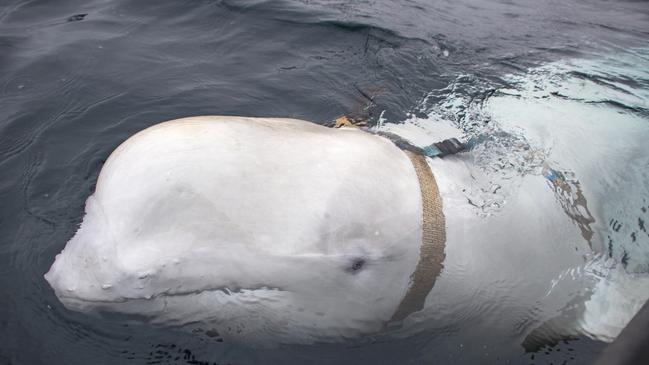Getting whales to spy isn’t the battiest idea
The beluga suspected of being a Russian agent is the latest in a long line of animal recruits to the military.

As the new Cold War heats up, it was inevitable that Boris the Russian Spy-Whale would surface.
Two weeks ago, a beluga wearing a special collar was found off the coast of Norway, prompting claims the Russians were training cetaceans to spy on the West.
It is an iron rule of every conflict that eventually the spymasters and generals get around to deploying animals, as offensive or defensive weapons, for espionage, or as propaganda to make the other side look idiotic: exploding rats, eavesdropping cats, retriever ravens, bomb-detecting sea lions, dolphins to protect military installations, pigeons to target missiles and carry messages, and remote-controlled sharks.
These all sound fantastical but all have been tested or deployed over the years.
The British are particularly keen on animal-based espionage and sabotage, a world where James Bond meets David Attenborough. In 1941, the chief of naval intelligence learnt that the Nazis had imported 1000 rhesus monkeys, possibly for “gas or bacteriological warfare”, or perhaps to infect the monkeys on Gibraltar and thus sap local morale.
Victor Rothschild, the head of MI5 counter-sabotage, was responsible for investigating spikes in animal purchases. Rothschild reported that German simian imports appeared to be benign but why they needed so many monkeys remains a mystery.
Animals make good spies. They reveal nothing under interrogation, move around without drawing attention and don’t get drunk. MI5 had an entire pigeon section during the war, dedicated to dropping homing pigeons in occupied Europe to which resistance fighters could attach messages to take back to Britain. The Nazis were so fearful of pigeons being used as covert messengers that the German Pigeon Federation was placed under the control of the SS.
For lunatic brilliance, few animal weapons can compare with the kamikaze bat bombs of 1942, a ruse to equip thousands of Mexican free-tailed bats with timed incendiary devices, which would then roost in the eaves of Japanese houses and burn them down.
The bat bomb was the brainchild of a Pennsylvania dentist, Lytle S. Adams, whose weapon was based on the following principles: hibernating bats are quite docile and do not require feeding in transit; bats can carry more than their body weight and fly in the dark; there are millions of bats in New Mexico; Japanese houses, being made largely of paper and bamboo, are highly flammable.
A bat bomb was designed (by the same US scientist who invented napalm) with a thousand tiny compartments, designed to float to earth by parachute, open in mid-descent and distribute the tiny, exploding warriors on unsuspecting Japanese cities. The suicide bats were tested at Carlsbad air base in New Mexico, where a couple escaped, roosted under a fuel tank and successfully set fire to the test range. President Franklin Delano Roosevelt approved the plan, codenamed X-Ray, but it was cancelled in 1945 on the grounds that the war would have ended by the time the US had assembled sufficient numbers of combat-ready bats.
Adams was upset, insisting that his invention would have been just as effective, but more humane, than the atom bomb: “Think of thousands of fires breaking out simultaneously … Japan could have been devastated, yet with small loss of life.” Except for the bats.
In the 1960s, the CIA spent an estimated $US14 million on a project to fit listening devices inside cats, based on the theory that felines were often left to wander freely around Russian meeting rooms. The project, inevitably named Acoustic Kitty, came to a sudden end during a field trial outside the Soviet embassy in Washington when the prototype eavesdropping cat was run over by a van. If the feline fatality sounds invented, it may well be, because many animal spy stories are thinly veiled propaganda.
The Arab-Israeli conflict has spawned numerous zoological espionage conspiracy theories. Birds identified as aerial Mossad spies include an eagle, a kestrel, a vulture, a stork and a bee-eater, all supposedly carrying electronic spyware when they were actually equipped with tracking devices to map migration patterns.
In 2007, the Iranian army arrested a team of 14 “spy squirrels” near a nuclear enrichment plant. The state news agency congratulated the security services for intercepting the furry intelligence-gatherers “before they could act”. Last year, Iran claimed that Western spies were smuggling chameleons into their country capable of detecting atomic waves through skin, and thus uncovering uranium mines (which they cannot).
In the science-fiction thriller The Day of the Dolphin, dolphins were trained to plant limpet mines on ships.
There are real dolphin armies too. When Russian forces took over the Crimea, they captured Ukraine’s team of the marine mammals, which had been trained to detect underwater explosives. Last year, it was reported the dolphins had almost all died in Russian captivity, prompting Ukrainian claims that these intelligent creatures had “patriotically” committed suicide by going on hunger strike in defiance of the “Russian invaders”.
I suspect the beluga collared off the coast of Norway is not a spy but a plant — a “dangle” in espionage jargon — and part of Vladimir Putin’s strategy of stoking uncertainty by giving the impression Moscow is deploying underwater agents. The whale was “discovered” because the Kremlin wanted it to be discovered and identified as Russian. Spies are supposed to be masters of disguise. This one was wearing a collar stamped with the words “Equipment St Petersburg”.
The Times


